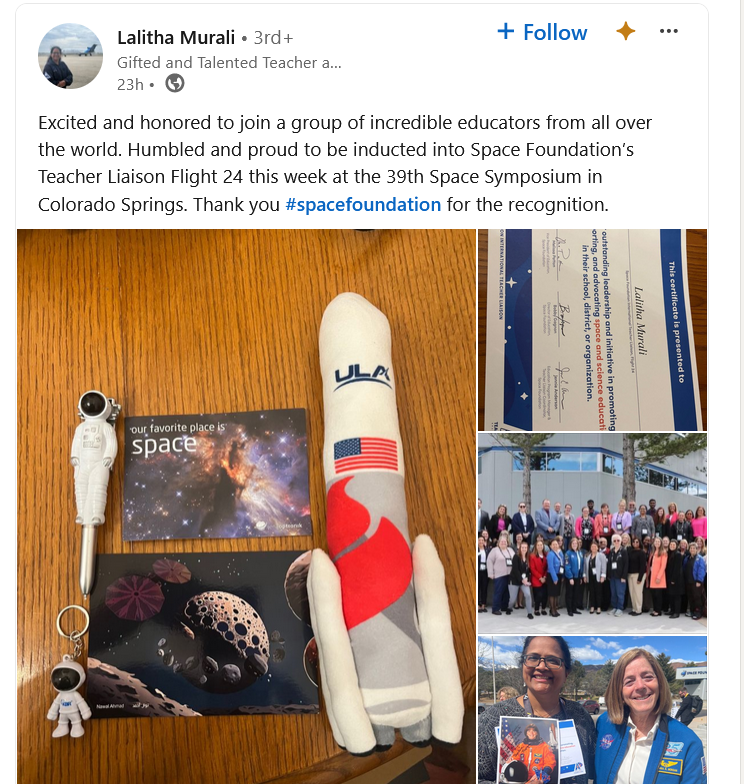
This is the fourth article in a series of articles on Innovation presented by the DPI’s Teaching and Learning Team.
Read Previous Innovation Series Articles:
Pathways to Hope: Innovation Starts Right Where You Are
Educators and Students Are Clamoring for Change and Making It Happen
What Arts Educators Can Teach Us About Cultivating Creativity and Innovation
This article was written in collaboration with Mark Schwingle, Gifted/Talented Education Consultant at the Wisconsin DPI.
Lalitha Murali, a science teacher from Glen Hills Middle School in the Glendale School District, never dreamed of working with NASA. Yet in March of this year, Murali did just that. She completed a zero-gravity space flight, bringing her students’ ideas and experiments with her.
When we think of innovation, we tend to think of grand ideas and concepts. Yet very often, innovation actually comes from following our curiosity.
Likewise, Murali’s innovation equation started with her interest, enthusiasm, and readiness for opportunity (something Murali credits to her students as inspiration).
Murali teaches at Glen Hills Middle School, which serves students in grades 4-8. According to WISEdash, of the nearly 500 students enrolled during the 2023-24 school year, 36% of Glen Hills Middle school are considered economically disadvantaged, 3% are English learners, 17% are students with an IEP, and 57% are students of color.
The diversity of Glen Hills scholars is an advantage and an opportunity. The challenge of meeting the needs of diverse learners is something that energizes Murali to think outside the box.
From Outside the Box to Defying Gravity
The path to Murali’s NASA zero-gravity flight started when she attended a summer professional development workshop. As Murali recounts, her innovation “wheels” began turning right away. Despite having a bachelor’s degree in physics, early on in the NASA project Mrs. Murali was concerned. When she arrived to start her PD at UW-Madison, “I was told that I was going to be working with Dr. Kawasaki in the Physics department. I was honestly a little bit disappointed. I thought, ‘Oh, here I thought I was going to be working in biology or chemistry to do experiments, I don’t know what kind of fancy experiments I can do in physics.’ But I was totally wrong.” She was wowed by the equipment and seeing and learning things she had only seen in science books.
She immediately brought back what she had learned to her students. Her students took that as a starting point and, as the saying goes, they blasted off from there.
Murali said, “the content is so interesting, motivating for them to absorb, and that is real life.” She credits the content as being the lever for innovation and learning. Murali sees her role in the classroom as a facilitator and as a person who provides interesting content and meaningful opportunities to her students.
Through collaboration and development with her students, together with NASA scientists, created experiments on how CO2 disperses in microgravity, Earth’s gravity, and Martian gravity (it’s a thing!). When you design an experiment, the next thing you do is test it. That required a space flight where Murali tested her students’ experiments.
To Infinity and Beyond!
As a result of this NASA project and flight, her students have presented at the regional STEM Forward Conference, the WATG conference, the 2023 International Space Development Conference and the Wisconsin Space Conference. Later this month they will be presenting at the International Space Conference.
Through her work with NASA, Murali was able to have Darian Dixon present to her class. ‘“He went to MPS and then he worked for NASA. Darian played a key role on NASA’s Perseverance Rover, which landed on Mars in February. Dixon was Perseverance’s Mastcam-Z data management lead. After his presentation, one Hispanic and one African American student both went up to him and said, ‘We want to be like you. What should we do to become like you? We want to work for NASA.’”
According to Murali, Mr. Dixon said, “‘You know what, that is my dream. That's why I came back to Milwaukee.’ And then my two students were his first [NASA] interns. He said, ‘You work with me. I will make sure you get into NASA.’”
Mrs. Murali’s students are clamoring for these opportunities, and seeing the results. She said, “opportunities come, I share with the kids. They want to do it, and then we do it.”
She started a STEM/NASA club, so more students can have an opportunity to engage with projects that can fuel their excitement and learning. Each opportunity springboards them all into more opportunities. Murali’s club (comprised of 6-8th graders) is working with UW-Milwaukee and NASA on pharmaceutical testing of a new drug. That new drug “...is going to go in the rocket and then after it comes back they are going to test … to see how the high altitude affected the physical and chemical properties of the drug.”
Murali’s students, “... are doing HiFi authentic research.” And all with “zero cost to the district.”
She believes that “[t]he most important thing a teacher can do is to have high expectations for all students and provide opportunities for them to be successful.” In addition, “I get excited when my kids are excited, you know?”
While Mrs. Murali’s experience with NASA is obviously quite unique, flight or no flight, the STEM classroom learning that has evolved from attending one PD is authentic, it is robust, and ultimately, it’s student-driven.
Students get to weave together their learning, their interests, and perhaps most importantly, their hope for the future. This is truly innovation and student engagement in action.
So, if you’re looking for a sign to take a leap with professional development, here it is.
One small step for educators, one giant leap for studentkind.